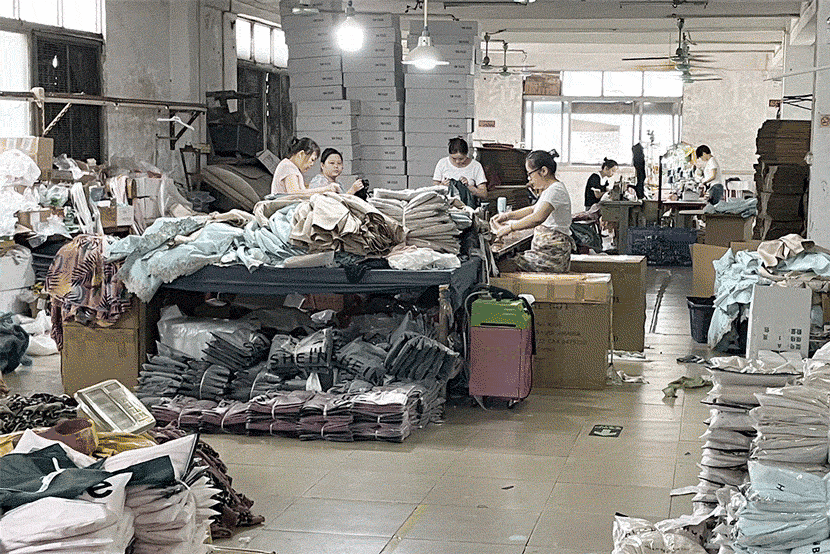Into the urban villages
In Guangzhou, it quickly became clear that even Shein sometimes isn’t sure exactly where its outfits are made.
After over a dozen failed attempts to convince Shein suppliers to discuss their relationships with the company, Sixth Tone traveled to an unregistered factory in a dilapidated industrial area on the outskirts of Guangzhou.
Inside, the factory’s owner, surnamed Chen, confirmed that he manufactured garments for Shein, but said he didn’t deal with the company directly. Instead, he received orders via another factory.
Like most of the people Sixth Tone spoke with in Guangzhou, Chen referred to Shein as Zoetop Business Co. Ltd., a Hong Kong-registered company owned by Shein founder Xu Yangtian.
“There were times when Zoetop Business came to my friend with very urgent orders,” said Chen. “He had to seek help from his friends to deliver on time.”
When orders arrive, Chen said his staff often have to work 15-hour shifts to finish everything before the deadline. The lead times for Shein’s orders are normally just seven days, whereas other clients usually allow two weeks, he added.

An exterior view of the building where Chen’s factory is located, in Guangzhou, Guangdong province, July 2021. Wu Peiyue for Sixth Tone
Chen signed no contract with his friend, let alone with Shein. He gets paid by his friend once he has received payment from Shein, he said. Chen refused to provide more information about the factory that subcontracts orders to him.
“Why don’t you go to South Village and Tangbu West Village?” Chen said. “Almost all the factories there work for Zoetop Business.”
South Village and Tangbu West Village are both “urban villages” — crowded neighborhoods that sprang up during the height of China’s economic boom, when millions of migrant workers flooded into Guangzhou to work in the city’s rapidly expanding manufacturing sector.
Each area is a labyrinth of narrow lanes lined with high-rise “handshake buildings” of varying shapes and sizes — many of them constructed by local residents without government permission. The first floors of these residential blocks are often rented to small garment manufacturers, which process orders in full view of passersby.
Now, many of these workshops are making outfits for Shein. When Sixth Tone visited the villages, workers inside dozens of street-side businesses could be seen sewing garments amid piles of plastic bags bearing the Shein logo.

A GIF shows staff working on an order from Shein inside Chen’s factory, in Guangzhou, Guangdong province, July 2021. Wu Peiyue for Sixth Tone
But like Chen, the workshops often have no contract — or even direct contact — with the company.
Several workshop owners told Sixth Tone they received their orders from nearby factories. When Sixth Tone visited several of these factories, the factory bosses confirmed that they produced goods for Shein but declined to discuss their relationships with the company.
“Shein called us recently and reiterated that we shouldn’t share any company information with outsiders, as a lot of business spies are out there trying to copy Shein,” one factory owner said.
This casual subcontracting of orders happens regularly within Shein’s supply chain, and the company appears to only have a limited level of control over the process.
A supply chain analyst at Shein, who requested anonymity as he wasn’t authorized to speak with media, told Sixth Tone the firm is trying to collect more information about its subcontractors and conduct inspections on safety and labor conditions in their facilities.
“The company isn’t against subcontracting,” the analyst said. “For example, we know that some of our suppliers in Guangzhou subcontract a large part of their orders to their friends and relatives in Guangxi province, as the labor costs there are much lower. We are trying to gain greater control over those factories.”
Yet Shein’s network of subcontractors continues to expand. Its suppliers are increasingly subcontracting orders to lower-wage parts of China, such as the eastern Jiangxi province, according to the Shein analyst. The network even extends as far as Liaoning province in northeast China, he added.
It’s unclear how many of Shein’s suppliers are small workshops, but Panyu District — the southeastern part of Guangzhou where South Village and Tangbu West Village are located — is one of the company’s main production hubs, according to domestic media. Shein reportedly works with 300-400 “core” factories and over 1,000 smaller “sub-tier” suppliers in the district.
Many of Shein’s fast-fashion competitors refuse to work with so many small-scale manufacturers, said Huang, the professor. The more subcontractors there are, the harder it becomes for them to police labor conditions within their supply chains, he added.
“It’s easier for manufacturers to ignore their responsibilities, and it’s easier to obscure the voices of workers,” said Huang.

Goods are stacked outside a factory that works as a direct supplier to Shein, in Guangzhou, Guangdong province, July 2021. Wu Peiyue for Sixth Tone






